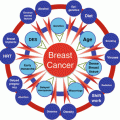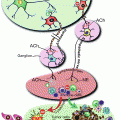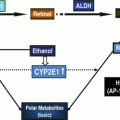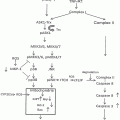ALDH2 genotypes (n)
*1/*1
*1/*2 + *2/*2
Authors
Case
Control
Case
Control
OR (95 % CI)
P
Nan et al. (2005)a [98]
286
462
135
168
1.30 (0.99–1.70)
0.061
Yokoyama et al. (2007)b [58]
29
242
16
39
3.42 (1.70–6.88)
0.001
Cao et al. (2010)c [102]
50
51
15
6
2.53 (0.86–7.49)
0.092
Shin et al. (2011)d [100]
53
44
15
3
4.26 (1.10–16.47)
0.036
Matsuo et al. (2013)e [97]
87
145
44
32
2.29 (1.35–3.88)
0.002
Combined significance
0.000
In congruence with the European studies on the positive association between the ALDH rs886205 C allele and UADT cancers [84, 90], the same allele and another minor allele of the rs16941667 SNP have also been associated to gastric cancer in European populations [103, 104]. These findings strengthen the evidence for a general carcinogenic effect of acetaldehyde also in non-Asian populations.
The overall significance (Table 3.1) demonstrates that there is sufficient evidence that acetaldehyde is a functional carcinogen in the stomach after chronic alcohol drinking, at least in East-Asian individuals carrying the ALDH2 (rs671)*2 allele.
3.3.4 Colorectal Cancer
Currently, at least 11 studies have been published on the association between colorectal cancer and the ALDH (rs671)*2 allele (Table 3.2) [32, 105–114]. Increased overall risk by the *2 allele was observed in a Japanese [32] and a Chinese [105] study. Increased risks were also shown in Japanese studies specifically for rectum [106] and colon [107]. Similarly, increased risks in Japanese populations were indicated by a gene–gene interaction with the ALDH2 (rs671)*2 allele combined with the ADH1B*2 [111] or CD36*C [113] alleles. On the other hand, the ALDH*2 allele was also associated with significantly lower risk in another Chinese study [114]. The four remaining studies displayed nonsignificant results [108–110, 112].
Table 3.2
Case–control studies on the association between the ALDH2 (rs671)*2 allele and colorectal cancer
Authors | 1/*2 + *2/*2 vs. *1/*1 OR (95 % CI) | P | Proportion of abstainers or low (<15 g/day) drinkers in the whole population (%) |
|---|---|---|---|
Chiang et al. (2012)a [105] | 1.76 (1.15–1.17) | 0.010 | No information |
Yokoyama et al. (1998)b [32] | 3.35 (1.51–7.45) | 0.017 | 0 |
Matsuo et al. (2002)c [106] | 1.80 (0.54–5.96) | 0.387f | 0 |
Murata et al. (1999)d [107] | 1.20 (0.77–1.87) | 0.437g | 39 |
Yin et al. (2007)e [108] | 1.07 (0.64–1.79) | 0.448 | 0 |
Otani et al. (2005)d [109] | 1.16 (0.73–1.86) | 0.549 | 32 |
Miyasaka et al. (2010)d [110] | 0.80 (0.41–1.48) | 0.528 | 54 |
Matsuo et al. (2006)d [111] | 0.99 (0.74–1.31) | 0.987h | 40 |
Yang et al. (2009)a [112] | 0.92 (0.72–1.17) | 0.494 | 78 |
Kuriki et al. (2005)d [113] | 0.80 (0.52–1.24) | 0.376i | 52 |
Gao et al. (2008)a [114] | 0.54 (0.30–0.98) | 0.050 | 48 |
In addition to the Asian studies, two European investigations have assessed the role of other ALDH2 alleles, namely, the rs441 [115] and the rs886205 and rs440 alleles [116], but without obtaining any significant results.
The seemingly discrepant data may partly be explained by the choice of control populations. As seen in Table 3.2, the higher the proportion of nondrinkers to very low drinkers is, the less indication of increased risk of the ALDH (rs671)*2 allele is achieved. As explained in Sect. 3.3.1, there are problems in including nondrinking control populations, because of the enrichment of the *2 allele. In addition the problem of active microbial endogenous alcohol metabolism in the gut may mask some of the effects by the alcohol-drinking-related acetaldehyde. Altogether, it seems that acetaldehyde here is a player, but in order to get sufficient evidence, future studies should better stratify and match the alcohol drinking of the control populations with the drinking of cancer patients.
3.3.5 Pancreatic Cancer
Little information (only three Japanese studies, two of which include about the same population) is available on the role of ALDH2 (rs671)*2 allele on pancreatic cancer [110, 117, 118]. After calculation of the original data, only nonsignificant results with higher frequency of the *1/*2 + *2/*2 vs. *1/*1 genotypes emerge, with ORs (95 % CI) 1.50 (0.95–2.38), P = 0.088 [118], and 1.15 (0.85–1.55), P = 0.401 [110]. The study displaying the trend [118] included only alcohol drinkers, while the study with P = 0.401 contained 54 % nondrinkers [110], which is in congruence regarding the studies on gastric and colorectal cancers (high proportion of nondrinkers reduces the significance). At this point there is no valid genetic–epidemiological data assessing a significant role of acetaldehyde in the etiology of pancreatic cancer.
3.3.6 Liver Cancer
Currently, at least 12 studies, all on East-Asian populations (ten Japanese and two Chinese), have been published on the association between hepatocellular cancer (HCC) and the ALDH (rs671)*2 allele [32, 119–129], nine of which are displayed in Table 3.3 [119–127]. The three studies not presented in Table 3.3 are inconclusive because of low number of cases, less than 25 per study and very few individuals carrying the ALDH (rs671)*2 allele (four individuals altogether). At first hand looking at Table 3.3, the data of the nine studies seem inconclusive with four studies showing a significant positive association between the *2 allele and risk for HCC [119–122], nonsignificance in four studies [123–130], and one significant negative association [129]. However, a closer view of the data demonstrates again the same phenomenon as for the gastric and colorectal cancers (see previous Sects. 3.3.3 and 3.3.4), i.e., the nonsignificance and negative correlation are most likely the consequence of a too high proportion of nondrinkers to low drinkers in the control group. The problem is the enrichment of the *2 allele individuals in the control population. Thus, it is hardly a coincidence that the three studies displaying negative associations are the studies in which the frequency of *2 allele individuals is highest compared with the *1/*1 genotype frequency of the control population, 62 %, 57 %, and 49 % in the studies [125–127], respectively. This means that most likely the role of acetaldehyde in the alcohol-related HCC has been underestimated.
Table 3.3
Case–control studies on the association between the ALDH2 (rs671)*2 allele and hepatocellular cancer (HCC)
Authors | 1/*2 + *2/*2 vs. *1/*1 OR (95 % CI) | P | Proportion of non-drinkers in the whole population (%) |
|---|---|---|---|
Kato et al. (2003)a [119] | 5.36 (2.10–14.02) | 0.000 | No information |
Tomoda et al. (2012)b [120] | 1.73 (1.19–2.51) | 0.005 | No information |
Sakamoto et al. (2006)c [121] | 2.13 (1.20–3.78) | 0.014 | 0 |
Munaka et al. (2003)d [122] | 9.77 (1.63–58.60) | <0.05 | 38 |
Ding et al. (2008)e [123] | 1.97 (0.79–4.89) | 0.185 | 0 |
Takeshita et al. (2000)f [124] | 1.46 (0.57–3.74) | 0.486 | 0 |
Koide et al. (2000)b [125] | 0.79 (0.43–1.45) | 0.536 | 41 |
Yu et al. (2002)g [126] | 0.74 (0.46–1.20) | 0.269 | 59 |
Shibata et al. (1998)h [127] | 0.44 (0.21–0.92) | 0.044 | 86 |
3.3.7 Lung Cancer
Currently, the association between the ALDH2 (rs671)*2 allele and lung cancer has been reported in two Japanese [32, 130] and two Korean [131, 132] studies (Table 3.4). Altogether, the combined data indicate a significant role of acetaldehyde in the etiology of lung cancer. The odds ratios and probabilities may be, at least to some extent, underestimated. For example, in the largest study of those displayed in Table 3.4, the frequency of the *2 allele individuals was considerably higher (67 %) compared to the *1/*1 carriers (33 %) in the control population [132], indicating an overrepresentation of the *2 allele in the reference group. New studies with better matched control groups will be needed for an even more valid assessment of the carcinogenic role of acetaldehyde in lung cancer in East Asia.
Table 3.4
Case–control studies on the association between ALDH2 (rs671) and lung cancer
ALDH2 genotypes (n) | ||||||
|---|---|---|---|---|---|---|
*1/*1 | *1/*2 + *2/*2 | |||||
Authors | Case | Control | Case | Control | OR (95 % CI) | P |
Yokoyama et al. (1998)a [32] | 5 | 443 | 2 | 44 | 8.20 (1.27–53.15) | 0.132 |
Minegishi et al. (2007)b [130] | 163 | 54 | 68 | 18 | 1.25 (0.68–2.29) | 0.550 |
Eom et al. (2009)c [131] | 112 | 103 | 20 | 13 | 1.69 (0.73–3.91) | 0.201 |
Park et al. (2010)d [132] | 322 | 688 | 396 | 728 | 1.16 (0.97–1.39) | 0.108 |
Combined significance | <0.010 | |||||
In addition to the role of ALDH2 (rs671)*2 allele in East-Asian lung cancer, one Norwegian study displays a higher risk for lung cancer by the minor allele of the ALDH2 rs4646777 SNP [133]. The role of this SNP as well as of other possibly important European SNP candidates needs to be evaluated in future studies.
3.3.8 Breast Cancers
All studies (one Korean [134], one Japanese [135], one Thai [136], and one Spanish [137]) on the role of ALDH2 in breast cancer have been nonconclusive. The Asian studies concerned the ALDH2 (rs671)*2 allele and the European study the minor alleles of ALDH2 rs737280, rs2238151, rs11066028, and rs11066034.
3.4 Summary and Conclusions
The general evidence for the carcinogenicity of acetaldehyde related to alcohol drinking is based on the cytotoxic, genotoxic, mutagenic, and clastogenic properties of acetaldehyde: acetaldehyde may form sister-chromatid exchanges and elevate micronuclei formation (general tumor biomarker) with a variety of DNA–acetaldehyde adducts; acetaldehyde adducts have been determined after alcohol intake in humans; acetaldehyde carcinogenicity has been shown in experimental animal studies; proximity between the locations of microbial activity, acetaldehyde exposure, and alcohol-drinking-derived cancers; and indication of carcinogenic effects by external acetaldehyde from the alcoholic beverage. This acetaldehyde should be recognized and considered for future assessments on limits for safe acetaldehyde concentrations in the alcoholic beverage. Currently, there is a need for developing new secure acetaldehyde regulations and directives for the alcohol industry.
The genetic–epidemiological evidence for the carcinogenicity of acetaldehyde is based on the positive association between the ALDH2 (rs671)*2 allele and cancer in the upper aerodigestive tract, stomach, colorectum, liver, and the lungs. Regarding the pancreas and breast, the data is still nonconclusive. The results of a number of investigations are hampered by choosing non- to low-alcohol drinkers as the control and/or reference group in comparing the rs671 genotype distribution in cases and controls. The thorough matching or stratification of alcohol drinking has also commonly been neglected. The result has been an erroneous interpretation of the data. Considering these difficulties clearly indicates that acetaldehyde, in addition to the already officially accepted carcinogenic effect in the upper aerodigestive tract, is most likely a responsible factor in the etiology of gastric, colorectal, hepatocellular, and lung cancers. Since the phenotypes (flushing and nausea) of the rs671 polymorphism are clearly expressed, they provide a valuable tool for future successful health education in the prevention of alcohol-drinking-related cancers.
Acknowledgment
This work has been supported by the Magnus Ehrnrooth Foundation and the Liv och Hälsa medical association.
References
1.
Newsholme A (1903) The possible association of the consumption of alcohol with excessive mortality from cancer. Br Med J 2241:1529–1531
2.
IARC (2010) Alcohol consumption and ethyl carbamate. IARC Monogr Eval Carcinog Risks Hum 96:1–1424
3.
IARC (2012) personal habits and indoor combustions. A review of human carcinogens. IARC Monogr Eval Carcinog Risks Hum 100E:1–575
4.
Secretan B, Straif K, Baan R et al (2009) A review of human carcinogens—Part E: tobacco, areca nut, alcohol, coal smoke, and salted fish. Lancet Oncol 10(11):1033–1034PubMed
5.
Sanchez-Alvarez R, Martinez-Outschoorn UE, Lin Z et al (2013) Ethanol exposure induces the cancer-associated fibroblast phenotype and lethal tumor metabolism: implications for breast cancer prevention. Cell Cycle 12(2):289–301. doi:10.4161/cc.23109 PubMedCentralPubMed
6.
Lieber CS, Baraona E, Leo MA et al (1987) International Commission for Protection against Environmental Mutagens and Carcinogens. ICPEMC Working Paper No. 15/2. Metabolism and metabolic effects of ethanol, including interaction with drugs, carcinogens and nutrition. Mutat Res 186(3):201–233PubMed
7.
Leo MA, Lieber CS (1999) Alcohol, vitamin A, and beta-carotene: adverse interactions, including hepatotoxicity and carcinogenicity. Am J Clin Nutr 69(6):1071–1085PubMed
8.
Hamid A, Wani NA, Kaur J (2009) New perspectives on folate transport in relation to alcoholism-induced folate malabsorption—association with epigenome stability and cancer development. FEBS J 276(8):2175–2191. doi:10.1111/j.1742-4658.2009.06959 PubMed
Stay updated, free articles. Join our Telegram channel

Full access? Get Clinical Tree








